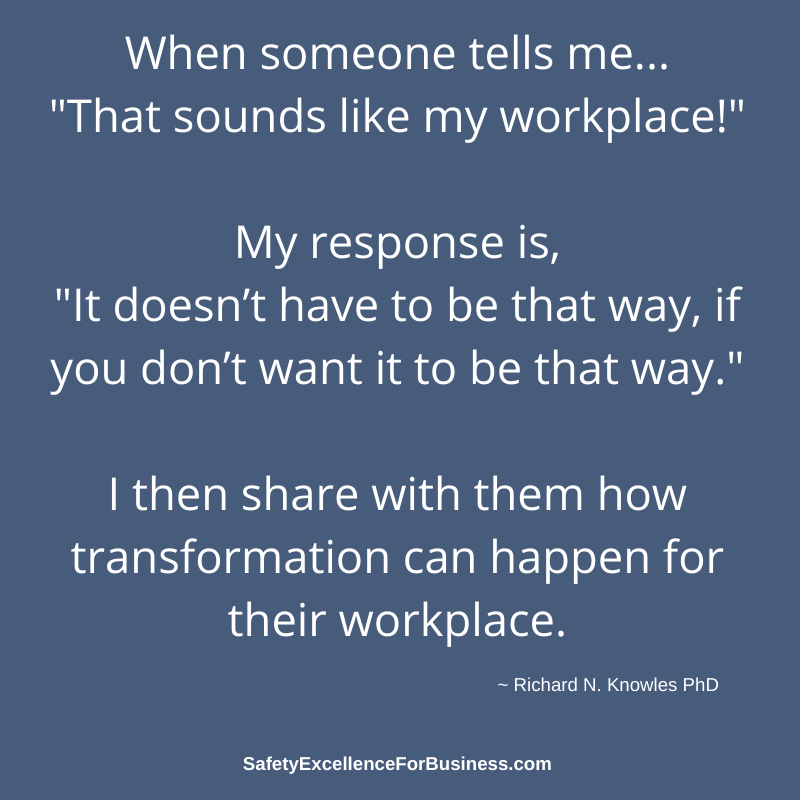A 19-Year Case Study
On Tuesday, August 18, 2020, from 4:15 to 4:45 PM, I will be making a virtual presentation at the AiCHE 16th Global Congress on Process Safety. The paper is a 19-year case study demonstrating a successful plant leadership transition that improved process safety performance.
 When I was transferred to the DuPont Belle, West Virginia plant in 1987, the Total Recordable Injury Case Rate (TRC) was about 5.8 and emissions to air, water and ground, as reported in the EPA Toxic Release Inventory (TRI) annual report, was over 6,000,000 pounds/year. Within three years, both of these had dropped by about 95% to a TRC of about 0.3 and a TRI of about 275,000 pounds/year. Emissions to the environment is one way to measure how well the process safety is working; the better the process safety work, the lower the emissions to the environment.
When I was transferred to the DuPont Belle, West Virginia plant in 1987, the Total Recordable Injury Case Rate (TRC) was about 5.8 and emissions to air, water and ground, as reported in the EPA Toxic Release Inventory (TRI) annual report, was over 6,000,000 pounds/year. Within three years, both of these had dropped by about 95% to a TRC of about 0.3 and a TRI of about 275,000 pounds/year. Emissions to the environment is one way to measure how well the process safety is working; the better the process safety work, the lower the emissions to the environment.
I was using a highly, participative leadership process I called Partner-Centered Leadership for Occupational Injuries and Health, as well as for Process Safety; this was a highly integrated process with just about everyone involved, and consciously working together to make our plant safer and have less impact on the environment. When I was transferred by DuPont in 1995 and replaced by a traditional plant manager using a top-down driven management process, things changed.
The process safety work was pulled away from the occupational safety and health effort and taken over by the managers. The occupational safety and health work continued to be led by the first and second level supervisors using the Partner-Centered Leadership approach. The highly participative leadership approach and the top-down management approach were running in parallel (the same business conditions, the same regulatory pressures, the same people, the same community). The occupational safety and health performance stayed at a rate of 0.3 or better for the next 15 years.
But the five different plant managers who came in during that period gradually cut back the process safety management resources and effort. They cut back on the manpower, allowed work-orders to pile up, stretched out the inspection intervals, ignored feedback from the operators and mechanics about the deteriorating conditions, etc. The TRI emissions rose by about ten-fold to over 2,500,000 pounds/year.
 The process safety management collapsed in January of 2010 with major, accidental releases to the air and river and they had a man get killed with a phosgene release. When the US Chemical Safety Board investigated in late 2010, they reported that while the occupational safety and health performance was the best in the DuPont Company, the process safety management had fallen apart and the plant was not even using the DuPont standard procedures. This was a sad commentary about how far things had fallen.
The process safety management collapsed in January of 2010 with major, accidental releases to the air and river and they had a man get killed with a phosgene release. When the US Chemical Safety Board investigated in late 2010, they reported that while the occupational safety and health performance was the best in the DuPont Company, the process safety management had fallen apart and the plant was not even using the DuPont standard procedures. This was a sad commentary about how far things had fallen.
This 19-year case study clearly shows that a highly participative leadership process produces much better results that the top-down management process.
An Online Course Offering
Beginning August 24th, I will be presenting a six-week course on Leadership and Using the Process Enneagram©. The Process Enneagram© was a key leadership tool I used when I was at Belle. I have used this tool successfully around the world with people in all sorts of organizations and businesses in the 25 years since I retired from DuPont. Wherever I have used it in my consulting, safety and total performance has improved.
This Online course is the first in a series to teach about leading and using the Process Enneagram©.






Speak Your Mind